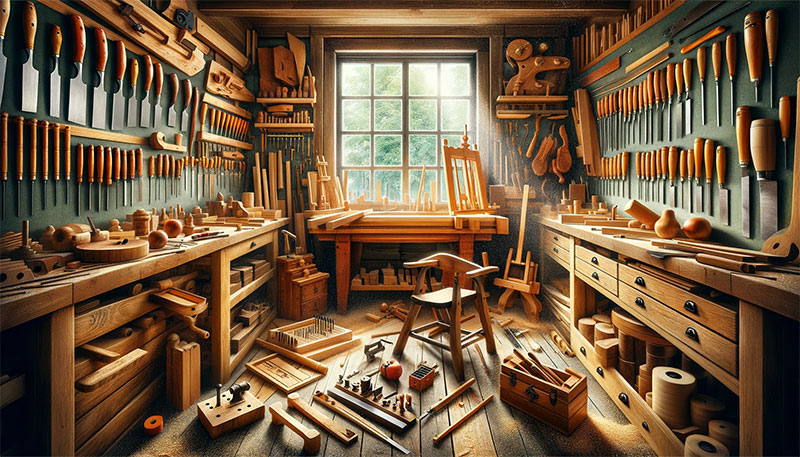Woodworking is a skillful art that requires patience and a deep understanding of the craft. Whether you’re a beginner or an experienced woodworker, this article provides expert tips and insights to enhance your woodworking skills and take your projects to the next level.
From setting up the ideal workshop to mastering fine woodworking techniques, this guide covers all aspects necessary for success.
So, if you’re ready to unlock the secrets of the woodworking world and improve your craft, let’s delve into this article and discover the valuable knowledge that awaits.
Key Takeaways
Woodworking Workshop: Improve Your Skills with Expert Advice
This article offers a comprehensive guide for individuals looking to enhance their woodworking skills. It covers everything you need to know, from setting up a workshop and understanding essential tools to ensuring safety and exploring various woodworking projects.
It also provides valuable insights into the world of RC woodworking and fine woodworking techniques. With helpful information on optimizing space and effective marketing strategies, this resource is suitable for both beginners and experienced craftsmen.
Setting Up Your Workshop
Setting up a woodworking workshop requires careful planning and consideration of various factors, such as space, tools, and safety measures.
One important factor to consider is the layout of the workshop. A well-designed layout can improve productivity and efficiency. It’s essential to allocate separate areas for different woodworking processes, like cutting, sanding, and assembly. This helps maintain a smooth workflow and reduces clutter.
Safety is also a top priority, so make sure there’s enough space to move around and store hazardous materials properly. Another crucial aspect is lighting. Sufficient lighting is necessary for precision work and preventing accidents. If natural light isn’t available, consider installing bright overhead lights or task lighting at specific workstations. Good lighting ensures that woodworkers can see their work clearly and make accurate cuts and measurements.
https://www.woodworkcenter.com/who-won-the-popular-woodworking-workshop-2/
Essential Tools for Woodworking
To engage in woodworking effectively, it’s important to have a set of essential tools that will enable you to work with precision and efficiency. Here are three tools that every woodworking enthusiast should have:
-
Circular Saw: This versatile tool is perfect for making straight cuts on different types of wood. With adjustable depth and angle settings, the circular saw is ideal for quickly and accurately cutting large boards or sheets.
-
Router: The router is an essential tool for advanced woodworking techniques. It allows you to create intricate designs, decorative edges, and joinery. By using different router bits, you can achieve a wide range of finishes and details, giving your projects a professional look.
-
Chisels: Chisels are indispensable for fine woodworking and carving. They are used to shape and remove wood, creating precise cuts and intricate designs. Having a set of high-quality chisels will enable you to achieve the level of detail and precision required for advanced woodworking techniques.
Safety Precautions and Practices
Now that we have covered the essential tools for woodworking, it is important to shift our focus towards safety precautions and practices to ensure a secure woodworking environment. Woodworking workshop safety is crucial to prevent accidents and injuries. Here are some key safety measures in woodworking that every woodworker should follow:
-
Personal Protective Equipment (PPE): Always wear safety glasses, ear protection, and a dust mask to protect your eyes, ears, and lungs from flying debris and harmful dust particles.
-
Tool Safety: Keep your tools clean, sharp, and in good working condition. Always use the appropriate tool for the job and follow the manufacturer’s instructions. Avoid distractions and maintain a clear workspace to prevent accidents.
-
Fire Safety: Keep a fire extinguisher nearby and be mindful of flammable materials in your workshop. Store solvents, paints, and finishes in a well-ventilated area away from heat sources.
-
Electrical Safety: Inspect your power tools and extension cords for any damage before use. Avoid using frayed cords and ensure they are properly grounded. Use circuit breakers and surge protectors to prevent electrical hazards.
-
Proper Handling and Storage: Always handle sharp tools with care and store them in a secure location. Keep your workspace clean and organized to minimize tripping hazards.
Beginner-Friendly Woodworking Projects
When getting started in woodworking, it’s important for beginners to choose projects that match their skill level and provide a solid foundation for learning and practicing essential woodworking techniques. Here are three woodworking project ideas that are perfect for beginners and emphasize workshop safety:
-
Simple Cutting Board: Making a cutting board is a practical and straightforward project that introduces beginners to basic woodworking techniques like measuring, cutting, and sanding. By using hardwood and finishes that are safe for food, beginners can create a functional and safe kitchen tool.
-
Wooden Tool Tote: Building a tool tote is an excellent project for beginners to learn about joinery techniques such as dado joints and dovetails. It also promotes organization and provides a convenient storage solution for woodworking tools, ensuring workshop safety by keeping tools within reach and preventing accidents.
-
Picture Frame: Creating a wooden picture frame allows beginners to practice mitered joints and explore different finishing techniques. It’s a versatile project that can be customized with various wood species and finishes, making it a perfect gift idea while honing woodworking skills.
Optimizing Space and Organization
Creating an efficient and well-organized woodworking workshop is essential for maximizing productivity and ensuring a safe and enjoyable working environment.
To achieve this, it’s important to optimize the available space and invest in practical storage solutions. By utilizing wall space with shelves, pegboards, and tool racks, you can keep your tools and materials organized and easily accessible.
Workbenches with built-in storage drawers and cabinets can also help declutter your workspace. Additionally, portable tool carts or cabinets that can be easily moved around provide another useful storage solution.
These storage solutions will save you time by eliminating the need to search for tools and materials, allowing you to focus more on your craft and increase productivity.
Exploring the World of RC Woodworking
To expand your woodworking skills and explore new creative possibilities, immerse yourself in the world of RC woodworking. RC woodworking combines the art of woodworking with the excitement of controlling and maneuvering remote-controlled models. Here are three benefits of RC woodworking that will surely fuel your passion for this unique craft:
-
Enhanced Creativity: RC woodworking allows you to build intricate models and experiment with different designs, pushing the boundaries of your creativity. You can build miniature boats, airplanes, and architectural models, among other things, to unleash your imagination.
-
Skill Development: RC woodworking requires precision and attention to detail, which will enhance your woodworking skills. Working with smaller components and incorporating mechanical systems into your models will improve your craftsmanship and problem-solving abilities.
-
Thrill of Control: Controlling your RC woodworking models is an exhilarating experience. Whether you’re maneuvering a small boat through water currents or flying an airplane through the sky, the sense of control and mastery over your creations is truly rewarding.
To delve into the world of RC woodworking, there are various resources available to help you learn and grow. Online forums and communities dedicated to RC woodworking provide a platform for enthusiasts to share their knowledge and experiences. Additionally, instructional videos, books, and workshops offer step-by-step guidance on building and operating RC woodworking models.
Mastering Fine Woodworking Techniques
Mastering the art of fine woodworking requires a deep understanding of the intricate processes involved in working with wood and a commitment to honing your craftsmanship skills. When it comes to advanced woodworking techniques, attention to detail and precision play a crucial role.
One particular aspect of fine woodworking that deserves special attention is the finishing process. A well-executed finish has the power to transform a simple piece of wood into a true work of art. To help you navigate the world of fine woodworking finishing, here are some key techniques to consider:
Staining: This technique involves applying a colored stain to enhance the natural beauty of the wood. It adds depth and richness to the wood, making it more visually appealing.
Varnishing: Coating the wood with a protective varnish is another important technique. This not only provides a glossy finish but also ensures durability and protection against moisture, extending the lifespan of your woodworking projects.
French Polishing: A technique that involves applying multiple layers of shellac using a rubbing technique. This creates a smooth, high-gloss finish with depth and warmth, giving your woodwork a luxurious appearance.
Hand-rubbed Oil Finish: Applying oil to the wood and rubbing it in by hand is a popular technique that enhances the natural grain of the wood. It provides a satin-like finish that showcases the beauty of the wood while providing protection.
Frequently Asked Questions
What Are Some Common Mistakes to Avoid When Setting up a Woodworking Workshop?
Avoiding common mistakes when setting up a woodworking workshop is essential. One mistake to avoid is neglecting proper safety measures. It’s important to prioritize the safety of yourself and anyone else who will be using the workshop. Another mistake is underestimating the space and equipment requirements. Take the time to carefully plan and ensure you have enough room for all your tools and materials. Lastly, don’t forget to plan for efficient workflow. Consider the layout of your workshop and how you can organize it to maximize productivity. Remember, attention to detail and thorough research are key to a successful workshop setup.
How Can I Ensure That I Am Using the Correct Screws for My Woodworking Projects?
Choosing the right screws for woodworking projects is essential. To ensure you use the correct screws, consider factors such as the thickness of the wood, material composition, and desired level of durability. By taking these factors into account, you can make informed decisions and ensure the success of your woodworking projects. Remember to use clear and straightforward language, provide context for the importance of choosing the right screws, and avoid using clichés or overused phrases. Additionally, it is helpful to include specific examples and product recommendations when necessary. Make sure to rewrite the text in your own words, correct any spelling and grammar errors, and check for plagiarism to ensure unique content. Finally, aim for a conversational writing style that mimics human writing, and avoid using words disliked by search engines for better indexing.
Are There Any Specific Safety Precautions to Take When Working With Certain Types of Wood?
When working with certain types of wood, such as exotic woods or reclaimed wood, it is important to take specific safety precautions. This includes wearing protective gear, ensuring proper ventilation, and being mindful of potential hazards like splinters or toxic chemicals. It is crucial to prioritize safety to prevent accidents and protect your health. By following these precautions, you can work with wood confidently and minimize any risks associated with the materials.
Can You Recommend Any Resources for Learning Advanced Woodworking Techniques?
When it comes to learning advanced woodworking techniques, there are various resources available to help you. One option is to explore books that are specifically focused on advanced woodworking skills and methods. These books provide detailed instructions and insights from experienced woodworkers, making them an excellent choice for expanding your knowledge in this area.
How Can I Effectively Market and Promote My Woodworking Business Locally?
To effectively market and promote your woodworking business locally, it’s important to connect with potential customers and industry professionals. One way to do this is by attending local networking events where you can showcase your unique woodworking creations and make valuable connections. Another effective strategy is to utilize social media advertising to reach a wider audience. By creating engaging content and showcasing your work on platforms like Facebook, Instagram, and Pinterest, you can attract attention and generate interest in your woodworking business. Remember to tailor your messaging to resonate with your target audience and highlight the key benefits of choosing your woodworking services. With a strategic approach to marketing and promotion, you can increase visibility, attract new customers, and grow your woodworking business in the local market.
Conclusion
Woodworking Workshop: Enhance Your Skills with Expert Tips
This article provides a comprehensive guide for individuals seeking to improve their woodworking skills. It covers everything you need to know, from setting up a workshop and understanding essential tools to ensuring safety and exploring different woodworking projects.
It also offers insights into the world of RC woodworking and fine woodworking techniques. With valuable information on optimizing space and effective marketing strategies, this resource is suitable for both beginners and experienced craftsmen.





